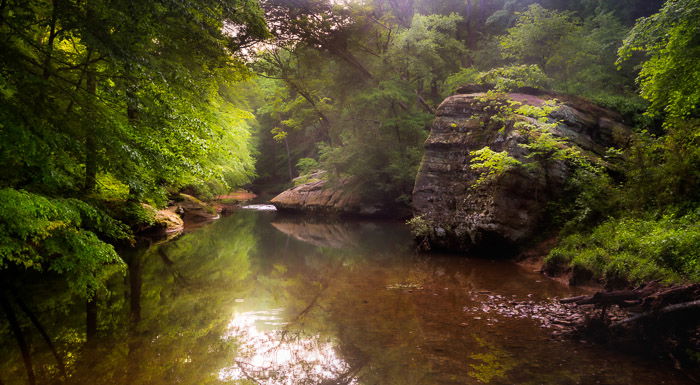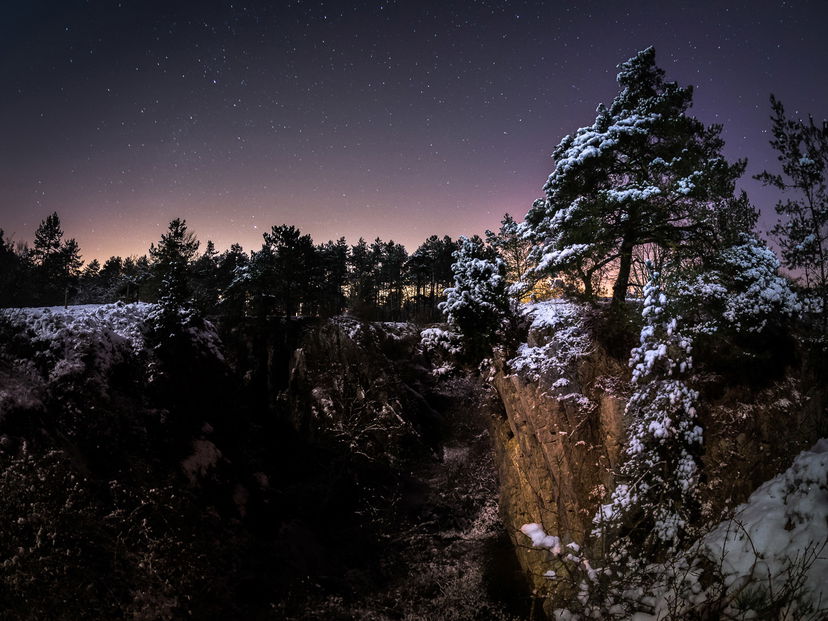How to Correctly Use the Orton Effect for Landscape Photos
The Orton Effect is a popular, artistic post-processing technique developed in the 1980s. The process is popular in landscape photography and creates a soft watercolor effect.
In this article, we’ll show you how to create the dreamy effect in Photoshop and Lightroom.
What Is the Orton Effect?
The Orton Effect is a post-processing technique used to add a romantic or mysterious look to landscape photography.
It’s named after Michael Orton, a Canadian landscape photographer who introduced a surreal vibe to his photos.
To apply the Orton Effect, he shot two or three photographs of the same scene. One was focused correctly, and the second he threw out of focus using a shallow depth of field. Both were often overexposed.
In the darkroom, Orton merged the images together, producing a single image that was sharp and blurry. The images tend to have an abstract and surreal feel, with a glow in the highlights.
Today, landscape photographers are more restrained in their use of the effect. They use it to add a soft glow to dramatic landscape photos, but usually do not apply it heavily.
It’s a straightforward process to achieve this look in Photoshop and Lightroom. It’s up to you how far you want to take the effect.
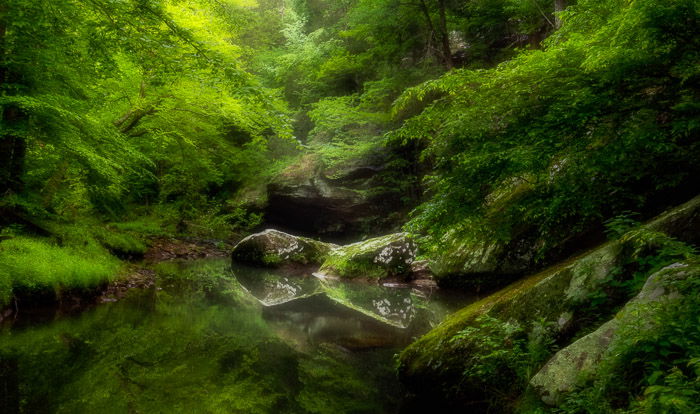
A dreamy landscape created using the Orton Effect. Post-processed in Photoshop. Photo by Jenn Mishra.
How to Create the Orton Effect in Photoshop
There are many ways to achieve the Orton Effect in Photoshop. Some involve using a blend mode and the Apply Image tool.
I find the best way is actually the simplest. Plus, you’ll have a lot of control over how much of the effect to apply to your photo.
Step 1. Create Layer
After applying basic edits to your photo, open the image in Adobe Photoshop and create a duplicate layer.
You can do this by right-clicking on the background layer and selecting “Duplicate Layer” (Ctrl or ⌘J).
I label this layer “Blur.”

Create a duplicate layer and label it “Blur.”
Step 2. Create Blur
Select the Blur layer.
We’re going to add a blur to this layer to add glow to the scene. Go to Filter > Blur > Gaussian Blur.

A screenshot showing how to navigate to Gaussian blur.
In the pop-up dialog box, select a radius value that blurs the scene.
At this stage, blur the scene a lot. Choose a radius between 25 and 50. You will control how much of the blur you see later in the process.

Gaussian blur dialog box showing blur preview.
Step 3. Add Contrast & Lighten Layer
Add contrast and lighten the photo by adding a “Levels” adjustment layer. Go to Image > Adjustments > Levels. Or click on the “Levels” icon in the Adjustments panel.
This step will take some experimentation to get the look you want. There’s no hard and fast rule. Try starting with Photoshop’s “Contrast 3” preset and then pull the highlights carrot and the shadows carrot left.
Click the “Clipping Mask” icon on the bottom left of the window. This applies the adjustments to only the Blur layer.

Add contrast and lightness to the blur layer and lighten the photo.
Step 4. Adjust the Strength of the Effect
Select the Blur layer and take the opacity down to 0%. This removes the Orton Effect entirely from your photo.
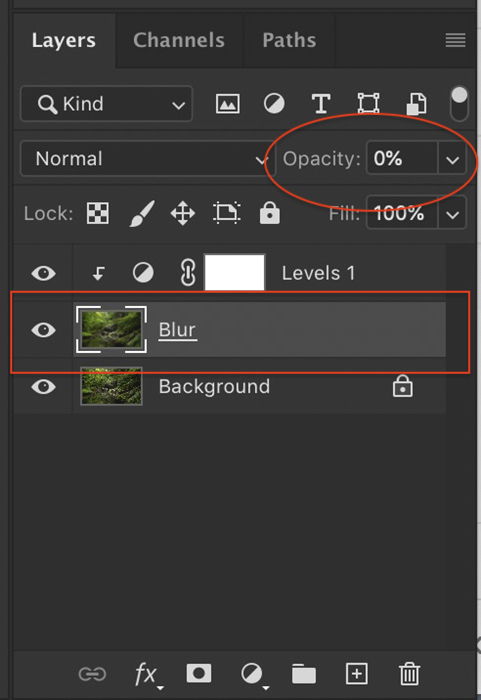
Reduce the opacity of the Blur layer to 0%.
From zero, slowly add the Orton Effect to your image. Many photographers like to be restrained and only add a little bit of the effect. Somewhere around 5 to 10%. Others, like Orton himself, like to go much more abstract and surreal.
Compare 15% opacity (before) with 35% (after).
The effect should be seen in the highlights more than in the shadows.
Add a layer mask to the Blur layer and paint out the effect with a black brush in the shadowed area.
How to Create the Orton Effect in Lightroom
You can achieve a similar look in Lightroom by using a combination of the Clarity and Texture sliders and lightening the image.
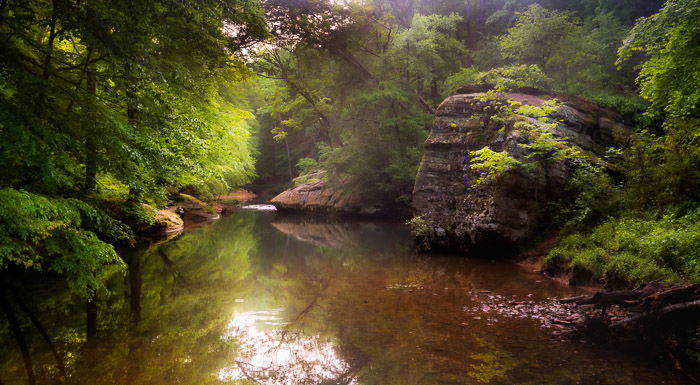
Bell Smith Springs in the morning with a little mist in the trees. Photo by Jenn Mishra.
Step 1. Lower Presence in the Develop Module
After applying basic edits to your image, go to the Basic panel in the Develop module. Look for a set of tools in the Presence section called Texture, Clarity, and Dehaze. These will be the most effective way to create the Orton Effect in Lightroom.
Often, we raise the numbers for landscapes by dragging the sliders to the right. For the Orton Effect, we’ll do the opposite.
Lowering the Texture slider decreases the texture in the image while retaining detail and clarity adjusts contrast in the midtones. How much you lower these sliders is up to you. Somewhere between -40 and -80 is a good range.
I sometimes add a little haze to the image by lowering the Dehaze slider.

In the Develop module, lower the Texture, Clarity, and Dehaze sliders.
Step 2. Add Contrast & Light
Clarity reduces contrast in the midtones, but it makes the image a bit lifeless. Add back some overall contrast and lighten the image. Orton overexposed his images, and you’ll want your highlights to glow.
There’s no one fixed recipe. I tend to lighten highlights, shadows, and whites in the Tone section of the Basic panel.

In the Develop module, raise the Contrast, Highlights, Shadows, and Whites sliders.
Compare the results. The first image was created in Lightroom. The second image was created using the above process in Photoshop. The results are similar, but not exactly the same.
Conclusion—How to Add the Orton Effect in Photoshop
Landscape images processed with the Orton Effect have a soft, ethereal look. The look is easy to achieve in both Lightroom and Photoshop.
Over-processed Orton Effect photos, like over-processed HDR images, are sometimes disparaged on social media. But Orton himself was going for an abstract look. It’s up to you how much of the effect to apply.
Applying a little blur and overexposure can create a dreamy landscape. Try it and see for yourself!


